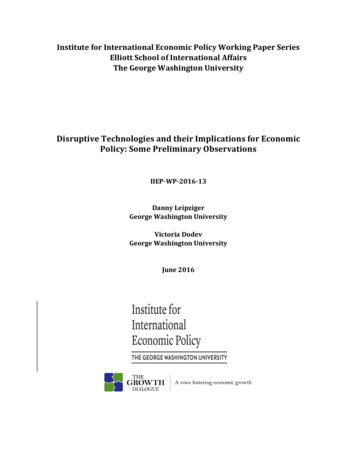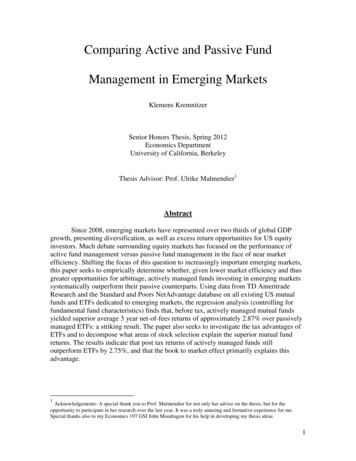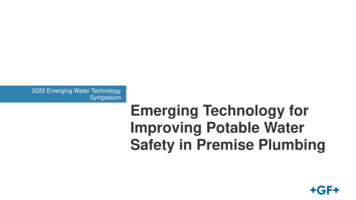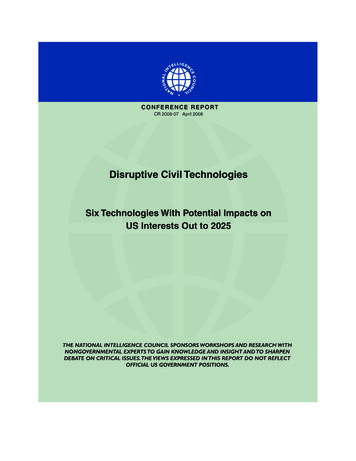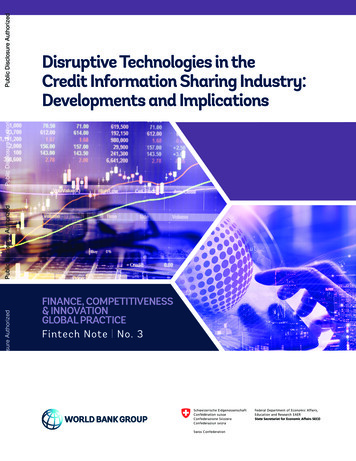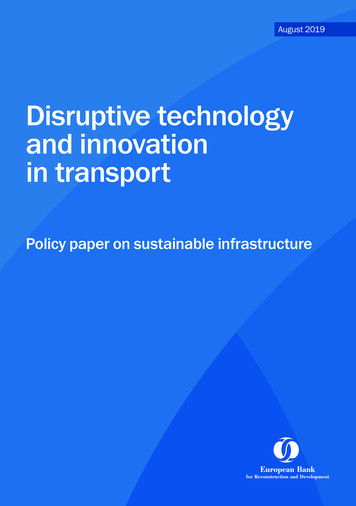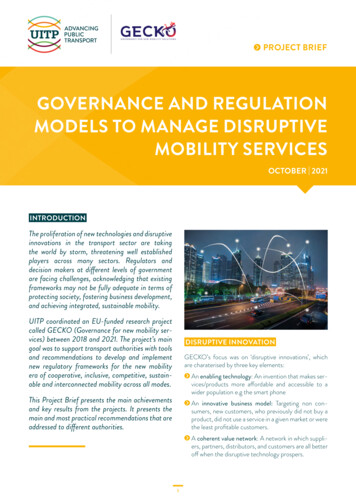
Transcription
INSTITUTE FOR DEFENSE ANALYSESIn-Use and EmergingDisruptive Technology TrendsLaura A. Odell, Project LeaderBrendan T. Farrar-FoleyJ. Corbin FauntleroyRyan R. Wagner31 March 2015Approved for public release;distribution is unlimited.IDA Non-StandardD-5457Log: H 15-000243CopyINSTITUTE FOR DEFENSE ANALYSES4850 Mark Center DriveAlexandria, Virginia 22311-1882
About This PublicationThis work was conducted by the Institute for Defense Analyses (IDA) undercontract DASW01-04-C-0003, Task BK-5-3754, “Web as a Service (WaaS), FutureOffice, COOP,” and Task BK-5-3448, “Next-Generation Networks,” for the Officeof the Secretary of Defense, Chief Information Officer Director, EnterpriseInformation Technology Services Directorate. The views, opinions, and findingsshould not be construed as representing the official position of either theDepartment of Defense or the sponsoring organization.AcknowledgmentsThomas H. Barth, Cameron E. DePuyCopyright Notice 2015 Institute for Defense Analyses4850 Mark Center Drive, Alexandria, Virginia 22311-1882 (703) 845-2000.This material may be reproduced by or for the U.S. Government pursuant to thecopyright license under the clause at DFARS 252.227-7013 (a)(16) [Jun 2013].
Executive SummaryThe Department of Defense (DoD) is facing rapid advancements in technology that willsignificantly change the way its information technology (IT) infrastructure is implemented and managed. Technologies are being developed and used in the commercial worldthat increase the efficiency of network resources, improve security across the network,and improve mobile access and collaboration. Many companies are implementing anytime, anywhere connectivity across their workforces to improve productivity, reducecosts, and increase mobility and collaboration in their workplaces. Expectations in a digital world, on a daily basis include instant communication, collaboration, and enhancedtechnologies that facilitate a mobile workforce in and outside the traditional workplace.DoD must adapt to the workforce’s use of technology to attract and retain the best and thebrightest. There is an implicit expectation that the technology in the workplace should beas good as or better than that at home.The Office of the Secretary of Defense (OSD) Chief Information Officer (CIO) askedIDA to research and assess emerging low-risk, high-impact technologies that would prepare DoD for a more mobile, agile, and efficient workforce. OSD CIO is the leader in ITand information management for networking, computing, information assurance, enterprise services, and applications for the Pentagon Reservation. The motivation for thiswork was the OSD CIO’s need to better understand the potential of emerging and in-usetechnologies to meet their strategic vision of dependable, reliable, and secure IT serviceswith easy access to network resources using up-to-date technology.The IDA team worked closely with the OSD CIO to identify nine potential solution setsthat could potentially improve the effectiveness and efficiency of the DoD IT infrastructure. The team examined current research, vendor information on cutting-edge and mature commercial products, technology standards, and related federal government programs to develop an understanding of technologies directly applicable to the Pentagonenvironment. A series of concise analysis summaries was developed to inform decisionmakers in a “quick-look” format. Each summary describes a specific technology, how itworks, its constraints and limitations within the current DoD environment, and the potential leverage points available within the current Pentagon information technology infrastructure. An industry snapshot in-use example is included in each summary as well. Thisdocument is a compilation of the nine summaries, which are described below.Containers: Moving Beyond Virtual MachinesThe development of virtual machines (VM) launched a major advancement in information technology. VMs mimic the hardware of a dedicated machine and make it possi-
ble to run the equivalent of many physical machines on just one physical machine. However, VMs must replicate the entire operating system (OS). As a result, it takes time toinstantiate a new VM because the machine must be booted up, adding to duplicativeoverhead that utilizes processing and storage, thereby reducing the number of VM instances that can run on a given physical host. To address this, some major IT service providers have turned to containers for running their services. Containers differ from VMs inthat they provide a lightweight layer of abstraction of the OS rather than an entire dedicated OS. In a VM environment, multiple VMs are running, each with an instantiation ofa full OS that is created and managed by the hypervisor. A container has only one OS,and each instance of the container shares the single OS kernel. This significantly reducesan application’s resource needs, but each container can support only one application at atime. Additionally, containers provide less isolation than VMs, causing additional security considerations. While VMs are separated by the hypervisor, containers are separatedby kernel-level functionality such as Linux kernel containment.A container approach is useful for applications that run in a cloud environment whichotherwise might comprise numerous VMs running in parallel. Containers greatly increaseefficiency. Writing applications to work within a container environment would allow better resource utilization on physical hosts and provide easier deployment of applications ina consistent environment. When utilizing third-party hosting solutions (on dedicatedhosts for security), containers provide a common framework for moving applications between cloud providers, which is critical in avoiding vendor lock-in and could be used forcontinuity of operations. However, the barrier between containers is thinner than that between VMs, so policy on containers must be implemented accordingly.Software-Defined Networking: A New Network ArchitectureMobile devices and content; cloud services; and end point, application, and server virtualization are putting significant stress on today’s hardware-centric network designs.Changes in a virtual environment can require reconfiguration of routers and switcheswithin a network. Network providers are moving away from static network configurations to a more flexible, agile approach, called software-defined networking, that will allow administrators to dynamically reconfigure the network through software and application programmatic interfaces (API). Software-defined networks (SDN) decouple the control and data planes (i.e., the software and hardware), allowing the network to be treatedas a virtual entity. The software-defined networking environment uses open APIs to support all services and applications running over the network. This allows the network administrator to manage services and applications without having to touch individualswitchers or routers. SDNs can be reconfigured on the fly, providing more robust networks that better tolerate failure and route around congestion.
SDN is an emerging architecture that industry is only beginning to use, and much of thework at this time has been focused on gaining data center efficiencies, not enterprise services. Since all information goes through the controller, scalability is a concern. Securityis also a concern. An SDN can provide and enforce a security strategy for the network,but this strategy is dependent on how well the SDN itself is protected. The benefits thatare derived from network programmability and centralized control also provide newthreat vectors that could compromise the network if security is not designed properlyfrom the start.De-Perimeterization: Removing the Network PerimeterThe concept of a network perimeter has been dead for years, but many have not noticed.The primary factors for this failure are: (1) a mobile workforce (via laptops, tablets, andphones) and (2) outsourcing services (e.g., travel, expense reporting, health care, and payroll) to third-party providers. The effect of these factors on the network environment isreferred to as de-perimeterization.The Jericho Forum describes de-perimeterization as “the erosion of the traditional ‘secure’ perimeters, or ‘network boundaries,’ as mediators of trust and security.” Deperimeterization diffuses the strict boundaries between the internal and external network,requiring organizations to authenticate and encrypt all IT services, which are made available on a least privilege basis (i.e., being inside the network perimeter does not itself allow unfettered access to network resources and data).In a de-perimeterized network, security controls are shifted from the network to the endpoints, data centers, information repositories, and applications. De-perimeterization assumes that everyone is untrustworthy, and so the concepts of identification, authentication, and authorization become very important. These concepts are applied at all levels,from user devices to application services to critical information assets. Security becomesa guiding principle for the network and is built into the architecture rather than layeredonto it. As a result, a de-perimeterized network is more secure because users and devicesare authenticated and access to services and data is controlled.Zero Trust: An Alternative Network Security ModelTraditional network security is based on the concept of a network perimeter that has limited access points into the network and that allows in only trusted users. Once inside, users can gain access to any number of resources on the network. This perimeter-basedmodel of security relies on the assumption that everyone and everything inside the perimeter can be trusted. The network perimeter has not adapted to meet the security challenges presented from remote employees, mobile users, or cloud computing, where theboundary between internal and external networks is blurred. As a way to adapt to thisblurring of the network perimeter, Forester Research proposes an alternative network se-
curity model, referred to as Zero Trust. This model takes into account both external andinternal threats, ensuring that malicious insiders cannot access information they are notauthorized to access, thus reducing the exposure of vulnerable systems and preventing thelateral movement of threats throughout the network. Instead of trusting users and theirdevices to do the right thing, the security model verifies that they are doing the rightthing. This means that no entity on the network is trusted based solely on network location, including users, devices, transactions, applications, and packets.One of the major benefits of using a Zero Trust security model is the improved management and fine-grained control of the security of the network. Zero Trust makes it easier toenforce security compliance across all users, devices, and applications and easier to identify all traffic by user, device, and application, allowing full visibility and control of network resources. Current security architecture designs overlay controls on the network;Zero Trust is a departure from that approach in that it embeds security into the heart ofthe network.Mobile Thin Client End PointsThe rise of the personal computer moved computing to the end user, with applicationsand data residing on the end point. With ubiquitous high-speed networks, virtualization,web-delivered applications, cloud-based storage, mobile apps, and increasing securitychallenges, applications and data are moving back to the data center, with the user connecting via mobile devices (mobile thin client end points). The traditional thin client typically stores configuration files and the OS on flash memory—no other data is stored locally—and connects to resources hosted in a data center. However, the mobile thin clienttakes the paradigm further by using a reduced, hardened OS and relying on web interfaces, application streaming to the browser, and virtual desktop interfaces to access resources. Mobile thin clients are easy to administer and deploy. Updates can be done securely and automatically. Security and usability are enhanced due to data and applications residing in the data center. Applications are web-based or streamed from a data center, and users are always up to date when opening applications, thus reducing expensiveand ineffective patching operations.End points are the most compromised part of the network; more than 90 percent of vulnerabilities are through Java and Flash plugins on the end point. Mobile thin clients protect against these types of vulnerabilities. Since the data remains on the server, there islittle opportunity for compromise due to loss of equipment (e.g., having a laptop stolen).They are also a good way to improve the management of end points, their applications,patches, and data. Updates only occur on the server, not on the device; data is always upto date on the server.
New Trends in Mobile BroadbandEach year cellular, or mobile broadband, providers see an increasing number of mobiledevices being used. It is estimated that by 2019 there will be over 9.2 billion mobile subscribers in the world, and over 80 percent of those will be for mobile broadband. 1 Thishigh usage is the leading driver for technology changes that will increase capacity andreduce the cost of mobile broadband networks. Mobile broadband allows users to connectto the Internet from any location where cellular services are available for mobile Internetconnectivity. Currently using licensed 225 MHz to 3700 MHz radio frequency bands,mobile broadband maintains Internet connectivity as the user moves from place to place.With the proliferation of smartphones, tablets, and other mobile devices, it is often assumed that mobile broadband will eventually replace Wi-Fi as the network of choice. Thereality is much different. The biggest issue facing mobile broadband is capacity. Networkcongestion in peak use times is not uncommon and data rates across the network slowsignificantly. To combat the problem, providers are beginning to offload data to carrieroperated Wi-Fi networks spread across metropolitan areas; these hotspots have more capacity and higher data rates. Major cellular providers are beginning to offer Wi-Fi as acomplement to their services and are partnering with cable communications companies togain access to their Wi-Fi hotspots.Emerging Wireless Technologies: Faster Speed More DataWireless networks are ubiquitous, and the desire for anytime, anywhere access with everincreasing speed and bandwidth has driven development of new technologies and ways ofdoing business. Recent advancements in V-Band, or millimeter wave (MMW), communications, have led to the development of networks with data transfer rates many timesfaster than those of today’s wireless technology. New short-range wireless communication devices using the unlicensed 60 GHz band (millimeter wave band) can provide datatransfer rates of up to 7 Gbps. The 60 GHz band (57 64 GHz) has more spectrum available—up to 7 GHz—than today’s 2.4 GHz and 5 GHz wireless solutions containing up to150 MHz.Wireless is also advancing into the visible light spectrum to create networks where datarides on light waves, referred to as visible light communications or Li-Fi. Light has ahigher frequency than radio frequencies. Li-Fi is essentially an array of flickering lightemitting diodes (LED) creating a binary (on 1, off 0) data flow, which can occur athigher rates than the human eye can detect, and a light sensor to detect the data flow; themore LEDs, the more data can be transferred over the network. By using Li-Fi-equipped1GSMA. “Will Wi-Fi relieve congestion on cellular networks?” May 5, 2014. 2014/05/Wi-Fi-Offload-Paper.pdf
light bulbs, the wireless network can be extended throughout the workplace and used toaugment existing networks.While product development for these emerging wireless technologies is only just beginning, these technologies are changing the future of mobile computing and future wirelessnetworks.Find Me, Follow Me: Leveraging Micro-locationWidespread use of mobile devices, such as cell phones and tablets, that routinely use GPSand Bluetooth to provide continuous location information, allows users to be tracked anywhere—both in and outdoors. Many applications pull information about objects, services,and people surrounding the device and at the same time push similar information to othernearby devices. Mobile devices containing these types of applications are becoming thestandard, making the concept of Find Me, Follow Me (FM/FM) possible in the workplace.The FM/FM concept comes from the phone industry—a result of individuals having multiple phones (e.g., office phone, cellphone) and not being tied to a specific location. It hasexpanded beyond the realm of telephony to end-user devices on the network. Microlocation sensors use a range of signals to triangulate and obtain a user’s position, including Global Positioning Systems (GPS), cellular, Bluetooth, Wi-Fi, and near field communication. Used in conjunction with geofencing, which provides a virtual fence around aspace or building so that information going into and out of the space can be limited orcontrolled, indoor micro-location allows routing of phone calls to the nearest phone oroffice, sharing of documents with some but not others, and automated check-in for aspace or meeting. Identity verification technologies are also an important part of FM/FM.Location is determined by device, and identity verification ensures that the correct user isassociated with the device. By deploying FM/FM technologies, such as indoor microlocation and identity verification, organizations may be able to be decrease labor costs,increase public safety, reduce insider threat, provide indoor navigation aids, and allowmeeting check-in, document sharing, and resource allocation optimization.Building Mobility into the Classified EnvironmentToday’s demand for wireless and cellular access in the Pentagon is overwhelming. Advances in wireless and mobile broadband technology now make it possible to provideseamless mobile access to information using commodity hardware and software. Deploying an architecture that supports secure wireless communications is a key factor in enabling mobility in a classified environment. An “all in one” wireless network architecturecurrently gaining traction uses the same physical infrastructure (including Wi-Fi radioequipment) for both classified and unclassified data. But deployment of wireless networks is only half the battle in enabling mobility; devices accessing the network must
securely support the network architecture and meet security constraints. Care must betaken to select devices that can use Wi-Fi in a sensitive compartmented information facility (SCIF) environment without emitting signals that could be remotely read by nearbydevices. Advancements in wearable medical devices present new challenges for classifiedwireless networks. Between collecting personally identifiable information, meetingAmericans with Disabilities Act (ADA) requirements, and accommodating returningAmerican veterans with wireless prosthetics and devices, planning for wearable devicesmust occur.It is inevitable that wireless networks and mobile broadband become part of the infrastructure that supports DoD in the Pentagon. Programs, such as NSA’s Commercial Solutions for Classified (CSfC) and DISA’s DoD Mobility Classified Capabilities (DMCC)are leading the way toward integrating classified and unclassified work. Governmentagencies should join forces to leverage DoD programs and NSA research to build a wireless network that has the ability to adapt to emerging technology and can reliably supporttenants at both the unclassified and classified levels.
ContentsContainers: Moving Beyond Virtual Machines . 1Software-Defined Networking: A New Network Architecture . 5De-Perimeterization: Removing the Network Perimeter . 9Zero Trust: An Alternative Network Security Model . 13Mobile Thin Client End Points . 17New Trends in Mobile Broadband . 21Emerging Wireless Technologies: Faster Speed More Data . 27Find Me, Follow Me: Leveraging Micro-Location . 33Building Mobility into the Classified Environment . 39
Containers: Moving Beyond Virtual MachinesThe development of virtual machines (VM) launched a major advancement in information technology. VMs mimic the hardware of a dedicated machine and make it possible to run the equivalent of many physical machines on just one physical machine. Thisapproach offers a number of benefits. First, VMs improve security by adding another layer of separation between applications running on a particular host. Second, because dedicated machines are often idle, using a combination of VMs can make better use of processing resources; for example, one VM can peak its utilization of the processor whileother VMs on the same physical equipment are idle. Third, VMs make it possible toquickly duplicate machines and move services from one physical host to another. Alongwith accommodating spikes in usage and improving continuity of operations, VMs allowthird parties to provide the basic physical infrastructure (e.g., space, electricity, environmental control, connectivity, and physical hardware) for a fee. The latter concept is oftenreferred to as Infrastructure as a Service.The problem with VMs is that theyreplicate the entire operating system(OS). Replicating the entire OS increases the time it takes to instantiatea new VM, because the machinemust be booted up, adding duplicative overhead that utilizes processingand storage, which reduces the number of VM instances that can run on agiven physical host. To address this,some major IT service providershave turned to containers for running their services.Virtual Machine ArchitectureContainer ArchitectureApp AApp BBins/LibsBins/LibsApp AApp BGuest OSGuest OSBins/LibsBins/LibsHypervisorContainer ServicesHost OSHost OSServerServerAdapted from: so-darnpopular-7000032269/What are containers? Containers differ from VMs in that they provide an abstraction ofthe OS rather than an entire dedicated OS. In a VM environment, multiple VMs are running, each with an instantiation of a full OS that is created and managed by the hypervisor (a virtual machine monitor). Each instance of a VM is heavily isolated from the others. A container has only one OS, and each instance of the container shares the single OSkernel. This significantly reduces an application’s resource needs.Why use containers? Because of their “lightweight” nature, containers can be startedfaster, require fewer resources, and allow more applications to run on a physical host. Acontainer can be started much faster than a VM because no additional OS needs to boot
up; the time savings can be significant because a VM needs additional configurationwhen booted for the first time. A recent PricewaterhouseCoopers analysis notes that,while a traditional VM takes over 30 seconds to boot, a container can start in a tenth of asecond. (Morrison & Riznik 2014) However, the savings are less meaningful in cases inwhich new instances are rarely needed.In comparing the KVM (Kernel-based Virtual Machine) tool for Linux to LXC (LinuxContainers), IBM researchers found that VMs are only half as fast at random memoryinput and output as containers running applications on the native OS. (Felter et al. 2014)The researchers also found that random memory read latency increased by two to threetimes, while containers maintained the same performance as a native application. Finally,a physical host can run four to six times as many containers as a VM when tuned appropriately. (Vaughan-Nichols 2014)In addition to scale, containers make it easier to deploy applications. Applications arewritten specifically to run within the container. By doing this, a standard interface may beused to communicate with multiple resources outside the container, such as a database. Adeveloper simply writes an application to function within a container, as opposed to developing the application to also communicate directly with various outside resources,leading to a simpler and cleaner development process. Additionally, if the development,test, and production environments all run the same container, then updates to applicationscan be done seamlessly. Containers could also lead to easier movement of applicationsbetween disparate clouds.In a way, developing an application for a container environment is much like loading ashipping container: one entity packs the container without having to worry about thingslike shipment method (e.g., ship, truck, train), and the transport provider moves the container from one location to another without needing to understand what is inside the container. Containers are an advancement in virtualization that furthers the innovations provided by VMs.Features of Virtual Machines and ContainersFeatureTime taken to start upMemory on disk requiredProcess IsolationContainer AutomationVirtual MachineSubstantially longer: Boot ofOS plus app loadingComplete OS plus appsMore or less completeVaries widely depending onOS and appsContainerSubstantially shorter: Only apps need tostart because OS kernel is already runningApp onlyIf root is obtained, container host could becompromisedDocker image gallery; othersSource: Microsoft virtual-machines-docker-vm-extension/)
What are the limitations? Containers have limitations. Each container can support only one application at a time. Additionally, containers provideless isolation than VMs, causing additional security considerations. While VMs are separated by thehypervisor, containers are separated by kernellevel functionality such as Linux kernel containment. (LCX 2014) Sharing physical hosts withnon-Department of Defense (DoD) tenants is notadvisable at this time. Because containers do notprovide a complete OS, they rely on the underlying OS to provide specific functionality. Currently, the most widely used container software runsonly within a Linux environment, which meansthat only applications that run in a Linux environment can run in a container. However, this ischanging. Microsoft is developing additional container support for Windows Server and the Azurecloud service. (Zander 2014) Although this currently limits the utility of this particular program,it does not limit the utility of the container approach in general.Docker 1.0Container support is growingrapidly across the industry. Forexample, Google uses containersfor its own infrastructure, running everything in a container,with over two billion containersstarted each week. With the release of Docker 1.0, a new opensource container technology,more companies are moving toward the use of containers intheir data centers and cloud environments. From financial institutions to software companies,Docker is bringing standardization to container technology inthe market place. Major companies supporting Docker includeMicrosoft (Azure), Google (Compute Engine), Red Hat(OpenShift), and Amazon (WebServices). Even virtualizationprovider VMware has plans tointegrate containers into its services. (Vaughan-Nichols 2014)What does this mean for DoD? A container approach is useful for applications that run in a cloudenvironment that otherwise might comprise numerous VMs running in parallel. It greatly increases efficiency. Writing applications to workwithin a container environment would allow better resource utilization on physical hostsand provide easier deployment of applications in a consistent environment. When utilizing third-party hosting solutions (on dedicated hosts for security), containers provide acommon framework for moving applications between cloud providers, which is critical inavoiding vendor lock-in and could be used for continuity of operations. However, thebarrier between containers is thinner than that between VMs, so policy on containersmust be implemented accordingly.What are the policy implications? Because containers are a relatively new technology,little policy guidance is available to guide those wishing to use this technology to managethe risk or employ it in a way that is interoperable across DoD. On the cloud service provider side, the DoD Chief Information Officer (CIO) should request that the Defense Information Systems Agency (DISA) assess the feasibility of offering a container-
compatible service. The service would involve the ability to run containers in the DISAor third-party cloud environment and the capability to orchestrate the instantiation andshutdown of container instances. Because some DISA-provided services might be runmore efficiently in containers than VMs, DISA should report on the feasibility of converting some services to run in containers within the next five years. DoD CIO, DISA,and interested Combatant Commands/Services/Agencies should create a policy for astandard implementation of containers that is conducive to use across the DoD. Based onenabling the consumer-driven needs for containers, DISA should develop guidance forthe secure development, configuration, and administration of container-based applications.ReferencesFelter, Wes, Alexandre Ferreira, Ram Rajamony, an
The Office of the Secretary of Defense (OSD) Chief Information Officer (CIO) asked IDA to research and assess emerging low-risk, high-impact technologies that would pre-pare DoD for a more mobile, agileand efficient workforce. OSD CIO is the leader in IT , and information management for networking, computing, information assurance, enter-
